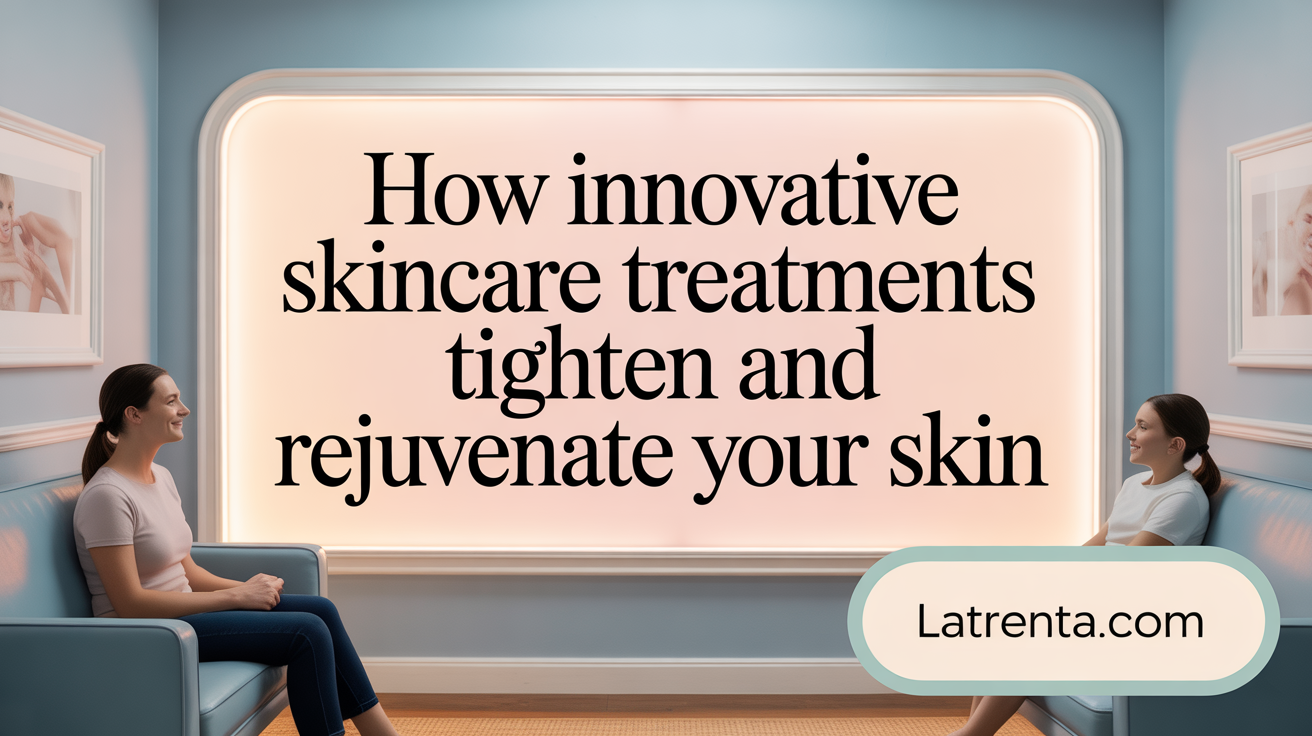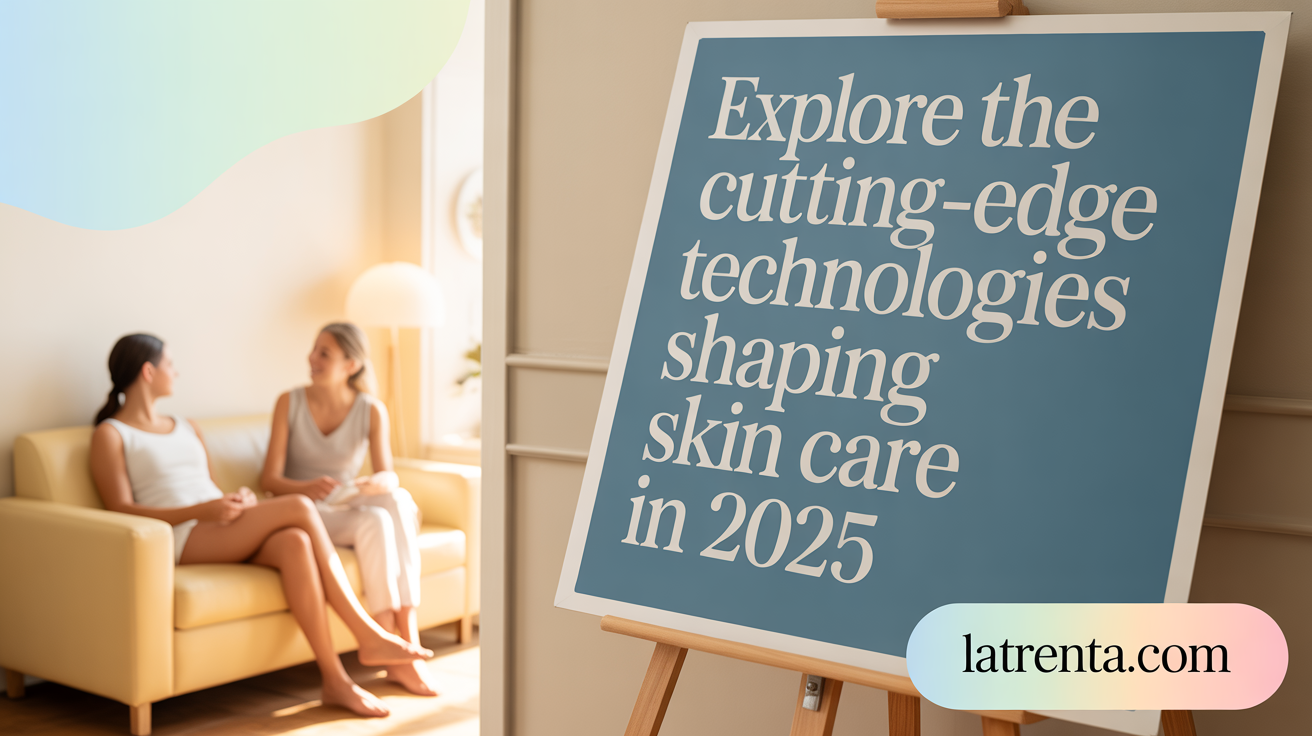Introduction to Non-Surgical Skin Tightening in 2025
As the desire for youthful, firm skin grows alongside advancements in aesthetic medicine, 2025 brings a refined selection of innovative non-surgical skin tightening treatments. These procedures employ cutting-edge technologies to stimulate collagen and elastin production, improving skin texture and firmness without incisions or significant downtime. This article offers a comprehensive overview of the most effective and popular options available today, helping readers make informed decisions tailored to their individual skincare needs and goals.
Popular Non-Surgical Skin Tightening Treatments and Technologies in 2025

Overview of leading non-invasive treatments
In 2025, the landscape of non-surgical skin tightening continues to evolve with advanced technologies that focus on stimulating natural collagen and elastin production. These options provide effective improvements in skin firmness, tone, and texture without the need for surgery or extensive downtime.
Key technologies: ultrasound, radiofrequency, laser, microneedling
Among the most prominent tools are ultrasound and radiofrequency (RF) devices. Ultrasound treatments like Ultherapy® use focused ultrasound energy to heat deep skin layers, encouraging collagen growth and lifting sagging areas. RF treatments, including Thermage®, Morpheus8®, and Renuvion, apply controlled heat to accelerate collagen production, resulting in skin tightening on the face, neck, and body.
Laser and micro-invasion techniques also play a crucial role. Laser resurfacing methods such as Fraxel Re:pair target fine lines, sun damage, and uneven skin tone, promoting collagen remodeling. Microneedling combined with RF, seen in devices like Morpheus8® and Exilis®, creates controlled skin injuries to boost collagen while tightening tissue.
Examples of FDA-cleared devices and procedures
Some of the most trusted, FDA-cleared options include:
| Device/Procedure | Technology Type | Main Benefits | Suitable Areas |
|---|---|---|---|
| Ultherapy® | Ultrasound | Lifts and tightens jawline, brow, neck | Face, neck, décolletage |
| Thermage® | Radiofrequency | Tightens skin on face and body | Face, arms, abdomen |
| Morpheus8® | RF Microneedling | Improves skin texture and firmness | Face, neck, and scars |
| Renuvion | Cold plasma energy | Firms skin post-weight loss | Loose skin on various body areas |
| Fraxel Re:pair | Laser resurfacing | Reduces wrinkles, scars, sun damage | Face, hands, chest |
| Exilis® | RF + Ultrasound | Combines fat reduction with skin tightening | Body and face |
These treatments are generally safe when performed by qualified professionals and typically involve minimal recovery time.
As technology advances, combining these methods—such as RF with micro-invasion or ultrasound with laser treatments—further enhances results. For instance, non-invasive devices like Venus Versa® and VelaShape® combine IPL and RF to address various skin aging concerns effectively.
In conclusion, 2025 offers a broad range of non-surgical options, from ultrasound to RF and laser technologies, providing safe, effective, and customizable solutions for skin tightening and rejuvenation. Regular consultation with a board-certified dermatologist or cosmetic specialist is essential to determine the most suitable approach based on individual needs and expectations.
Mechanisms and Effectiveness of Non-Invasive Skin Tightening Procedures

How skin tightening works non-surgically
Non-invasive skin tightening procedures use targeted energy sources like ultrasound, radiofrequency, or laser technology to heat the deeper layers of the skin. This controlled heating stimulates the body's natural production of collagen and elastin, essential proteins that provide skin with firmness and elasticity. Unlike surgical lifts, these treatments do not involve cuts or removal of excess skin; instead, they focus on encouraging your skin to become tighter and more toned from within.
Many of these procedures are quick, minimally invasive, and performed in outpatient settings, making them appealing options for those seeking subtle improvements without significant downtime. Results are gradual, often beginning to appear within a few weeks and continuing to improve over months.
Collagen and elastin stimulation
The core mechanism behind these treatments is collagen and elastin regeneration. Collagen provides structural support, while elastin allows the skin to stretch and bounce back. As we age, production of both slows down, leading to sagging and wrinkles.
Energy-based treatments like Ultherapy, Thermage, and Sofwave deliver focused heat to specific depths, triggering the skin’s natural healing response. This process encourages new collagen strands to form, tightening the skin and diminishing signs of aging. Similarly, Renuvion uses helium plasma that contracts collagen fibers, creating an immediate tightening effect.
Timeline and duration of results
Most non-surgical skin tightening effects unfold over several months. For example, Ultherapy effects usually become noticeable within 2 to 3 months as collagen builds. Renuvion, on the other hand, may show improvements within a few weeks, with final results developing over 3 to 6 months.
The longevity of results varies based on individual factors, but generally, the effects last up to one or two years. Maintaining a good skincare routine, including sun protection and topical retinoids, can help prolong the benefits.
Comparison of procedures such as Ultherapy and Renuvion
Ultherapy uses focused ultrasound energy to target deep layers of tissue beneath the skin, making it effective for lifting and tightening sagging areas of the face, neck, and brow. It is FDA-approved and offers visible lifting effects that can last from 1 to 2 years, with gradual improvements over 2-3 months.
Renuvion combines helium plasma with radiofrequency energy to cause immediate collagen contraction and stimulate further collagen production over time. It is typically used for more substantial skin tightening, especially after significant weight loss, and can produce more noticeable results in a shorter period.
While Ultherapy is well-suited for mild to moderate laxity and provides a natural lift, Renuvion’s deeper collagen contraction makes it preferable for more pronounced loose skin. Both treatments are minimally invasive but vary in cost, with Ultherapy generally costing between $2,000 and $4,000, and Renuvion ranging from $3,000 to over $15,000 depending on the area treated.
Summary comparison:
| Treatment | Technology | Main Benefits | Duration of Results | Suitable For |
|---|---|---|---|---|
| Ultherapy | Focused ultrasound | Lifts face and neck, tightens skin | 1-2 years | Mild to moderate laxity |
| Renuvion | Helium plasma + RF | Immediate contraction, long-lasting | 2+ years | Significant skin laxity post-weight loss |
| Sofwave | Ultrasound (mid-dermal) | Handles early aging signs, wrinkles | About 1 year | Fine lines, early sagging |
Ultimately, the choice depends on individual skin concerns, age, and desired outcomes. Consulting with a qualified dermatologist can help identify the most suitable procedure for each unique case.
Benefits, Potential Drawbacks, and Suitability of Non-Surgical Skin Tightening

What are the benefits, effectiveness, and potential drawbacks of non-surgical skin tightening treatments?
Non-surgical skin tightening procedures, such as radiofrequency, ultrasound, and laser therapies, offer a minimally invasive alternative to surgical lifts. They work by delivering targeted energy to heat deeper skin layers, stimulating collagen and elastin production. This process gradually improves skin firmness, texture, and tone for a more youthful appearance.
One of the biggest advantages is the minimal recovery time. Most treatments involve little to no downtime, allowing individuals to return to daily activities immediately. The results are natural-looking and develop over a few months, usually reaching peak effects within 2 to 6 months post-treatment. With proper skin care, including sun protection and hydration, these results can last between one to three years, though maintenance treatments are often needed.
Compared to surgical options, non-invasive treatments pose lower risks, less discomfort, and significantly reduced costs. They are more accessible and appeal to those seeking subtle, natural enhancements without scars or extensive recovery. However, their effectiveness is limited to cases of mild to moderate skin laxity. For significant sagging or excess skin, surgical procedures may be necessary.
While generally safe, these treatments can cause side effects such as redness, swelling, and mild burns if not performed properly. Rare complications involve skin burns or hyperpigmentation, particularly in darker skin tones. Nevertheless, when administered by qualified professionals, the safety profile remains high.
The main potential drawbacks include the temporary nature of results and the need for ongoing maintenance. Additionally, moderate to severe sagging may not be fully addressed through non-surgical means, highlighting the importance of realistic expectations.
Are these treatments suitable for all skin types and conditions?
Most non-invasive skin tightening procedures are safe across a broad spectrum of skin colors and types, with side effects mainly limited to temporary redness and swelling. Candidates are typically individuals experiencing mild to moderate skin laxity, often due to aging, sun damage, or weight fluctuations.
Ideal candidates are those who maintain a healthy weight, do not have active skin infections, and are in good overall health. Proper patient assessment by a board-certified dermatologist ensures safety and helps tailor treatment plans for optimal outcomes.
Overall, these therapies are suitable for a wide range of people seeking subtle improvements without surgical risks. However, those with significant skin excess or severe sagging may need surgical interventions for more dramatic results.
Personalizing Treatment: Choosing the Most Appropriate Non-Surgical Option
How can individuals choose the most appropriate non-surgical skin tightening treatment based on their individual skin concerns and conditions?
Selecting the right non-surgical skin tightening procedure involves careful assessment of personal skin concerns and goals. Many individuals seek treatments for mild to moderate skin laxity, fine lines, or early signs of aging in specific areas such as the face, neck, or body.
A consultation with a qualified dermatologist or cosmetic surgeon is crucial. During this appointment, the professional evaluates factors like skin type, degree of laxity, target areas, and overall health. This assessment helps in understanding what treatment modalities—such as ultrasound, radiofrequency, laser, or combined approaches—are best suited to the individual's needs.
Different options have distinct mechanisms. For instance, ultrasound treatments like Ultherapy focus ultrasound energy at specific depths to stimulate collagen production. Radiofrequency devices, such as Thermage or Exilis, heat deeper layers to promote collagen growth and skin tightening. Some combinations, like IPL with RF, address skin tone irregularities alongside laxity.
Candidates should have realistic expectations. Results from non-invasive procedures typically develop gradually over 2 to 6 months, and several sessions may be required to achieve the desired effect. It’s important to understand that these treatments are most effective for mild to moderate laxity, rather than significant sagging that may require surgical intervention.
Ultimately, a personalized treatment plan devised by a skilled professional ensures that the selected procedure aligns with individual skin conditions, lifestyle, and patient goals. This tailored approach maximizes safety, efficacy, and overall satisfaction with the results.
Trends and Technological Advancements in Non-Surgical Skin Tightening for 2025

What are the latest trends and advancements in non-surgical skin tightening technology in 2025?
In 2025, the landscape of non-surgical skin tightening continues to evolve rapidly, driven by innovative technologies and combined treatment approaches. One notable development is the emergence of micro-coring devices like Ellacor. These systems use micro-coring technology to remove micro-thin amounts of skin tissue, which stimulates collagen growth while avoiding scars or significant downtime. This approach offers a minimally invasive alternative to traditional skin tightening procedures.
Simultaneously, radiofrequency (RF) technology has seen significant enhancements. Devices like QuantumRF 10 and IgniteRF utilize advanced sensors and targeted energy delivery to reach deeper skin layers with precision. These systems provide controlled heating to stimulate collagen production from within, offering personalized results with minimal discomfort and rapid recovery.
Multi-modality treatments are gaining popularity as well. For example, EmbraceRF combines the benefits of FaceTite—a minimally invasive RF-assisted facial contouring procedure—with Morpheus8 RF microneedling. This combination enables comprehensive lifting, tightening, and skin smoothing without surgery. Such therapies are especially appealing to patients seeking non-invasive facelift alternatives.
Laser technology remains at the forefront, with innovations like Fraxel Re:pair and SmartLipo PrecisionTx improving skin texture and inducing collagen. These laser systems deliver precise energy to target problem areas, enhancing skin resilience, reducing wrinkles, and restoring firmness.
Market growth is largely fueled by the continuous improvements in RF, high-intensity focused ultrasound (HIFU), laser, and hybrid devices. As these technologies become more sophisticated, they cater to a broader demographic—particularly middle-aged adults—who desire preventive skin maintenance and minimally invasive rejuvenation options.
In summary, 2025’s non-surgical skin tightening trends reflect a move toward safer, more effective, and customizable treatments that combine multiple technologies for optimal results. As research advances, the integration of regenerative medicine enhances these options further, promising even more natural and long-lasting outcomes.
Maintenance and Complementary Skin Care for Prolonged Results
Daily skincare essentials post-treatment
To maintain the benefits of non-invasive skin tightening procedures, consistent daily skincare is crucial. Cleanse your skin thoroughly, and incorporate gentle exfoliants to promote cell turnover. Using specialized products that boost collagen and improve skin elasticity can enhance and prolong results.
Role of SPF, hydration, creams, and diet
Protecting your skin from UV rays with a broad-spectrum SPF is essential to prevent further damage and sun-induced laxity. Hydration plays a vital role; drinking adequate water helps maintain skin suppleness. Applying hydrating creams, especially those containing hyaluronic acid, supports skin elasticity. A balanced diet rich in antioxidants, vitamins, and minerals helps nourish your skin from within, contributing to longer-lasting effects.
Support from professional facials and chemical peels
Regular professional facials and chemical peels complement skin tightening by deep cleansing, exfoliation, and stimulating collagen production. These treatments can improve skin texture, reduce appearance of pores, and enhance overall radiance, ensuring your skin remains healthy and firm.
Integration with injectables for enhanced rejuvenation
Combining skin tightening with injectables such as dermal fillers and Botox can provide comprehensive facial rejuvenation. Fillers restore lost volume, while Botox smooths dynamic wrinkles, creating a smoother, more lifted appearance. This integrated approach maximizes results, offering a natural look with minimal downtime.
Maintaining your skin’s firmness involves a combination of consistent skincare, sun protection, professional treatments, and strategic injectables, ensuring long-term rejuvenation and youthful skin in 2025.
Overview of Non-Invasive Rejuvenation Options Beyond Skin Tightening
Injectables like Botox and dermal fillers
Botox remains a popular choice for quick wrinkle smoothing by relaxing facial muscles. Results appear within days and last up to four months. Dermal fillers, often made from hyaluronic acid, restore volume and enhance contours instantly, improving areas such as lips, cheeks, and under-eye hollows for a natural look.
Laser and light therapies for pigmentation and texture
Advanced laser treatments, including PicoSure, fractional laser resurfacing, and IPL, effectively target sun damage, pigmentation, enlarged pores, and uneven skin tone. PicoSure uses pressure waves to stimulate collagen, while fractional laser improves skin texture and resilience. IPL reduces redness and pigmentation, giving the skin a more uniform appearance.
Emerging therapies such as EMFace and Emsculpt NEO
EMFace is a breakthrough non-invasive treatment that combines high-intensity facial electromagnetic stimulation (HIFES) with synchronized radiofrequency energy. It reduces wrinkles, tightens skin, and boosts collagen production, with results gradually appearing over three months. Emsculpt NEO uniquely combines RF with high-intensity focused electromagnetic (HIFEM) technology to burn fat and strengthen muscles, leading to a toned, firmer appearance with secondary skin benefits.
Holistic approaches combining muscle strengthening and skin treatments
A comprehensive skin rejuvenation plan in 2025 often includes combining muscle toning procedures like Emsculpt NEO with skin tightening treatments such as RF microneedling and laser therapy. Incorporating skin care routines with retinoids, high-SPF sunscreens, and professional facials enhances overall skin health and prolongs results. Hydration and healthy habits further support youthful, firm skin.
| Treatment Type | Primary Focus | Duration of Results | Additional Notes |
|---|---|---|---|
| Botox | Wrinkle smoothing | Up to 4 months | Quick, minimally invasive |
| Dermal Fillers | Volume restoration | Immediate, lasts several months | Natural-looking contours |
| Laser/IPL | Skin tone, pigment | 1-2 weeks to see results | Multiple sessions may be needed |
| EMFace | Facial lifting, collagen | Results in 3 months | Needle-free, no downtime |
| Emsculpt NEO | Muscle toning, fat reduction | 6 months to 1 year | Combines muscle and fat benefits |
With technological advancements and personalized treatment plans, non-invasive skin rejuvenation in 2025 offers safe, effective options with minimal downtime to maintain a youthful glow and improved skin quality.
Choosing Your Path to Firmer Skin in 2025
The landscape of skin tightening without surgery in 2025 is rich with advanced, safe, and effective options suitable for a variety of skin types and concerns. From high-intensity ultrasound and radiofrequency devices to innovative micro-coring and hybrid treatments, individuals seeking non-surgical solutions can achieve noticeable lifting and rejuvenation with minimal downtime. Success depends on selecting the right treatment in consultation with qualified professionals, setting realistic expectations, and maintaining results through proper skincare and lifestyle choices. Embracing the best non-surgical approach empowers patients to refresh their appearance naturally and confidently, shaping the future of aesthetic medicine with personalized, minimally invasive solutions.
References
- Non-Surgical Skin Tightening - American Board of Cosmetic Surgery
- Best Without Surgery - Top Non-Invasive Treatments for 2025
- 4 Effective Non-Surgical Neck Tightening Procedures To Try in 2025
- The Top 4 Best Skin Tightening Treatments to Try in 2025
- Best Skin Tightening Treatments for the Stomach To Try in 2025
- Top Energy-Based Skin Tightening Treatments Revealed - NewBeauty
- 8 Most Effective Skin Tightening Procedures to Book in San Diego in ...
- Best Skin Tightening Treatments to Try in 2025
